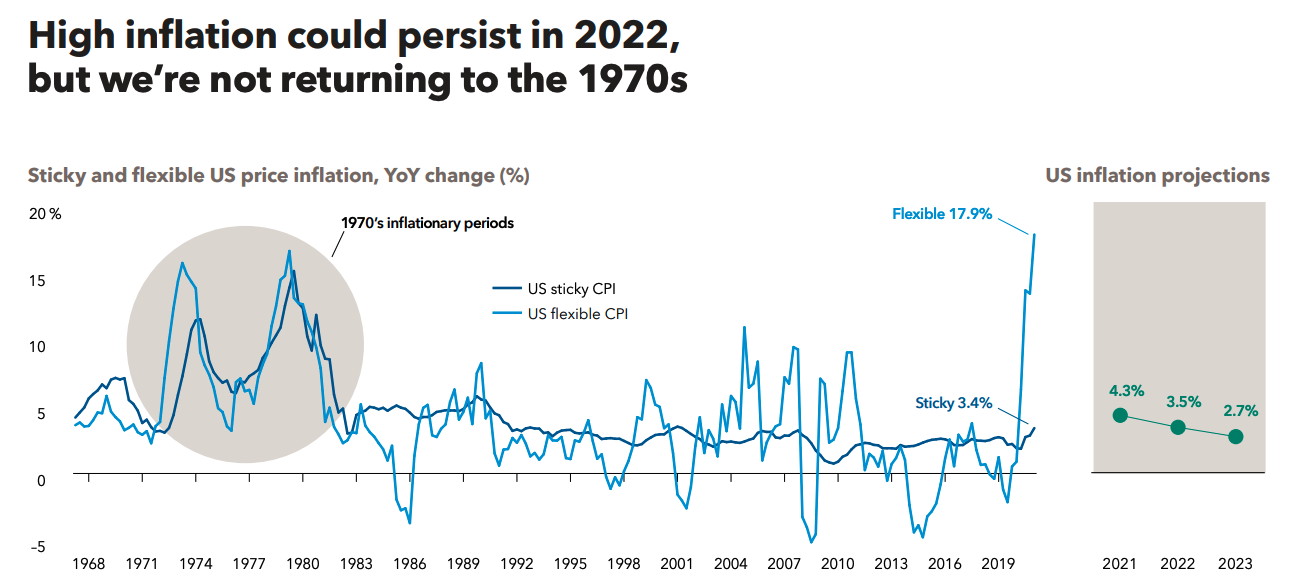Capital Group: In 2022, the risks are clear but the big picture is positive
A sweeping analysis of how 2022 is likely to turn out for financial markets and investors, Capital Group’s outlook cuts across global stocks and bonds in the US, China and Europe. It also explores dominant macro themes of interest rates and inflation, at the same time delving into some of the team’s more nuanced perspectives.
In his introduction, Capital Group vice chairman and president Rob Lovelace acknowledges the risk of what he regards as a late-stage bull market.
“In particular, the ongoing war between inflation and deflation could define markets in the years ahead,” he says. “The risks are clearly defined: Global economic growth is slowing, especially in China. Central bankers have started a gradual reduction in monetary stimulus measures. And valuations are elevated across the board, from stocks to bonds to real estate.”
But above all, Lovelace remains optimistic for investors who rely on selective investment selection based on fundamental research.
And Capital Group’s political economist Matt Miller discusses how political uncertainty often has a noticeable short-term effect on markets. He explains how an analysis of more than 90 years of equity returns reveals US stocks tend to have lower average returns and higher volatility for the first several months of midterm election years.
Amid the deafening “noise” generated by politics around the world, he emphasises the need “prudent investors to look past the short-term highs and lows and maintain a long-term focus.”

Pricing power is important; here's how to measure it
The ability to adjust prices in the face of threats (or opportunities) is a key attribute Capital Group looks for. This is particularly the case in our current economic climate, where official interest rates and inflation are rising.
That said, Capital Group’s equity portfolio manager Diana Wagner doesn’t believe rising inflation will be sustained.
“But I do believe rising costs will linger in the months ahead, making it the biggest risk investors face in 2022. That’s why I am so focused on uncovering companies with pricing power,” Wagner says.
“If we take US inflation as an example, the upside risk is in the sticky components,” says fixed income portfolio manager Ritchie Tuazon. “Those are the categories that will drive inflation in 2022, so that’s what investors need to keep an eye on.”
While Tuazon expects inflation to eventually return to normal levels, he also thinks it makes sense to guard against the threat of sustained higher prices through investments in inflation-linked securities, dividend-paying stocks and companies with pricing power. Those strategies may not fully shield investors from inflation, but they might help mitigate some of the impacts.
Companies with pricing power
The report points to Netflix as a high-profile example of a company that has pricing power and is not afraid to use it. The streaming platform’s “insatiable demand” – fed by hit shows such as Squid Game – has enabled it to lift subscription fees four times in 10 years.
Other examples are found among companies providing essential services such as healthcare, consumer businesses and industries with good supply-demand dynamics such as microchip-makers and luxury goods. Some examples include:
- Pfizer and United Health Group
- Coca-Cola
- TSMC and ASML
- LVMH and Kering.
Beyond big tech: The digital revolution goes global
And while we mostly hear about the big US tech giants – many of which are now valued at more than US$2 trillion – Capital Group emphasises digitalisation is a global trend. As part of this:
- Global spending on digital transformation is expected to rise from US$1.3 trillion in 2020 to US$2.4 trillion in 2024, according to Statista.
- Personal care companies like L’Oréal in France and appliance maker Midea Group in China have ramped up their digital adoption.
- Not every company that embarks on a digital transformation will emerge as a long-term winner. Each company’s digital strategy and prospects for success must be individually weighed.
“Some investors may think exclusively about consumer tech giants or cloud-based software providers, but you need to dig deeper across all industries to discover companies with the potential to benefit from a digital transformation,” says equity portfolio manager Greg Wendt.
The great dividend comeback
From the slashed (or cancelled) dividends of early 2020, the tide has turned. Many companies now have surplus capital to be deployed as either catchup or regular dividends.
As Capital Group’s Caroline Randall explains, her team focuses on not just the highest yielding companies, but on those with strong underlying earnings growth that have demonstrated a capacity and commitment to raise dividends over time.
This is important from the total return perspective of listed companies, helping them keep up with – or beat – the broader market. But it also plays into the higher inflation narrative.
“Because it is reflective of stronger earnings, dividend growth can also offer a measure of resilience against interest rate hikes,” says Randall.
Some company examples with strong histories of paying meaningful and growing dividends she cites include:
- Semiconductor makers Broadcom and TSMC
- Financials Zurich Insurance Group and TD Bank
- Utilities such as electricity and gas provider Enel, and
- Telecommunications conglomerate Comcast.
Interest rates – moving higher, but gradually
The Capital Group report looks at what’s on the horizon from the US Federal Reserve, particularly the sequencing of its actions including tapering of its record bond-buying. It also compares the current and likely future interest rate positions for the Bank of Japan, Bank of England and European Central Bank.
The report emphasises that, whatever actions the central banks take, they will be data-dependent and rely on outcomes more than forecasts. And the overarching variable, as it has been since early 2020, is COVID-19, particularly the Omicron variant that continues to disrupt the economic recovery around the world.
How bonds will perform as rates rise
Comparing the relative strengths and weaknesses of different credit assets, from high-yield and investment-grade bonds, key factors considered here include:
- Duration and interest rate sensitivity
- US high-yield corporate bonds, particularly the highest-quality BB-rated portion
- The importance of flexibility to move between different parts of the credit risk spectrum.
Changing labour markets
The key attribute of labour markets in developed economics currently is “tightness”, which occurs when there are too few candidates for the jobs that need filling by industries and individual companies.
There are three key parts to this:
-
Concerns about inequality: This could drive more activism and lead to industrial action and work stoppages. A key underpinning here is employees pushing for higher wages and an end to racial and gender discrimination in workplaces.
-
Workplace preferences: There is an ongoing shift in the types of incentives employees demand, which now extend beyond simple remuneration considerations towards work-life balance and “purpose-driven” organisations. These trends are plainly evident when comparing the 2017 and 2021 versions of Mercer’s Global Talent Trends Study, which shows a distinct shift.
-
Innovation and new skills: The competition for talent is heating up as digitisation and new technologies ramp up, often faster than companies can upskill their staff.
In short, Capital Group regards how companies think about the people inside their organisations as a crucial front in the ongoing battle companies fight to stay competitive and relevant.
How to invest in China
The elephant in the room during any discussion about China is the rising risk of growing government intervention and the fluid regulatory environment. Capital Group emphasises the need to understand the local market to invest in China, as in all global markets.
The flipside of the risks is that plenty of attractive long-term opportunities exist when you search on a stock-by-stock basis.
The biopharmaceutical sector is one example of an industry that is more aligned with the Chinese Government’s strategic priorities.
“Authorities have been pushing policies that encourage and incentivise domestic companies to compete with global companies," says investment analyst Laura Nelson Carney. "In that sense, biopharma is a little different than other industries in China that have been flagged as the next potential targets in line for heightened regulatory scrutiny.”
Click here to read the full Capital Group report.
Put today’s investment insights into a long-term perspective
Capital Group believes in a smarter way of investing that combines individuality and teamwork into a tailored approach to help investors meet their goals. To discover more about Capital Group visit their website here.
3 topics
1 contributor mentioned

